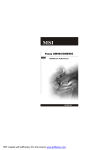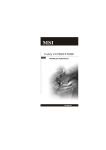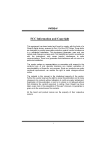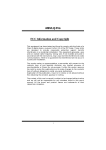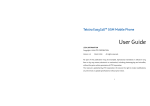Download Intel IM-Q35 Series User's Manual
Transcript
IM-Q35 Series MS-9820 (V1.X) Mainboard G52-98201X1 i PDF created with pdfFactory Pro trial version www.pdffactory.com Copyright Notice Th e material in this d ocument is the in tellectual p rop erty of MICRO-STAR INTERNATIONAL. We take every care in the preparation of this document, but no guarantee is given as to the correctness of its contents. Our products are under continual improvement and we reserve the right to make changes without notice. Trademarks All trademarks are the properties of their respective owners. Intel® and Pentium® are registered trademarks of Intel Corporation. AMD, Athlon™, Athlon™ XP, Thoroughbred™, and Duron™ are registered trademarks of AMD Corporation. NVIDIA, the NVIDIA logo, DualNet, and nForce are registered trademarks or trademarks of NVIDIA Corporation in the United States and/or other countries. PS/2 and OS ®/2 are registered trademarks of International Business Machines Corporation. Windows® 2000/NT/XP/Vista are registered trademarks of Microsoft Corporation. Netware® is a registered trademark of Novell, Inc. Award® is a registered trademark of Phoenix Technologies Ltd. AMI® is a registered trademark of American Megatrends Inc. Revision History Revision V1.0 Revision History First release Date May 2008 Technical Support If a problem arises with your system and no solution can be obtained from the user’s manual, please contact your place of purchase or local distributor. Alternatively, please try the following help resources for further guidance. Visit the MSI website for FAQ, technical guide, BIOS updates, driver updates, an d oth er in forma tion : htt p:// glob al.m si.com.tw /ind ex.p hp? func=service Contact our technical staff at: http://ocss.msi.com.tw ii PDF created with pdfFactory Pro trial version www.pdffactory.com Safety Instructions 1. Always read the safety instructions carefully. 2. Keep this User’s Manual for future reference. 3. Keep this equipment away from humidity. 4. Lay this equipment on a reliable flat surface before setting it up. 5. The openings on the enclosure are for air convection hence protects the equipment from overheating. DO NOT COVER THE OPENINGS. 6. Make sure the voltage of the power source and adjust properly 110/220V before connecting the equipment to the power inlet. 7. Place the power cord such a way that people can not step on it. Do not place anything over the power cord. 8. Always Unplug the Power Cord before inserting any add-on card or module. 9. All cautions and warnings on the equipment should be noted. 10. Never pour any liquid into the opening that could damage or cause electrical shock. 11. If any of the following situations arises, get the equipment checked by service personnel: † The power cord or plug is damaged. † Liquid has penetrated into the equipment. † The equipment has been exposed to moisture. † The equipment does not work well or you can not get it work according to User’s Manual. † The equipment has dropped and damaged. † The equipment has obvious sign of breakage. 12. DO NOT LEAVE THIS EQUIPMENT IN AN ENVIRONMENT UNCONDITIONED, STORAGE TEMPERATURE ABOVE 600 C (1400F), IT MAY DAMAGE THE EQUIPMENT. CAUTION: Dan g er of exp losion if b attery is in correctl y rep laced . Replace on ly with the same or equivalent type recommen ded by the manufacturer. iii PDF created with pdfFactory Pro trial version www.pdffactory.com FCC-B Radio Frequency Interference Statement Th is eq u ip men t h as been tested and found to comply with the limits for a Class B digital device, pursuant to Part 15 of the FCC Rules. These limits are designed to provide reasonable protection against harmful interference in a residential installation. This equipment generates, uses and can radiate radio frequency energy and, if not installed and used in accordance with the instructions, may cause harmful interference to radio communications. However, there is no guarantee that interference will not occur in a particular installation. If this equipment does cause harmful interference to radio or television reception, which can be determined by turning the equipment off and on, the user is encouraged to try to correct the interference by one or more of the measures listed bel ow. † Reorient or relocate the receiving antenna. † Increase the separation between the equipment and receiver. † Connect the equipment into an outlet on a circuit different from that to which the receiver is connected. † Consult the dealer or an experienced radio/television technician for help. Notice 1 The changes or modifications not expressly approved by the party responsible for compliance could void the user’s authority to operate the equipment. Notice 2 Shielded interface cables and A.C. power cord, if any, must be used in order to comply with the emission limits. VOIR LA NOTICE D’INSTALLATION AVANT DE RACCORDER AU RESEAU. Micro-Star International MS-9820 This device complies with Part 15 of the FCC Rules. Operation is subject to the following two conditions: (1) this device may not cause harmful interference, and (2) this device must accept any interference received, including interference that may cause undesired operation. iv PDF created with pdfFactory Pro trial version www.pdffactory.com WEEE (Waste Electrical and Electronic Equipment) Statement v PDF created with pdfFactory Pro trial version www.pdffactory.com vi PDF created with pdfFactory Pro trial version www.pdffactory.com vii PDF created with pdfFactory Pro trial version www.pdffactory.com CONTENTS Copyright Notice .................................................................................................... ii Trademarks ............................................................................................................ ii Revision History .................................................................................................... ii Technical Support ................................................................................................. ii Safety Instructions ................................................................................................ iii FCC-B Radio Frequency Interference Statement ................................................... iv WEEE (Waste Electrical and Electronic Equipment) Statement ................................ v Chapter 1 Product Overview .......................................................................... 1-1 Mainboard Specifications ............................................................................. 1-2 Block Diagram ............................................................................................... 1-4 Mainboard Layout ........................................................................................ 1-5 Board Dimension .......................................................................................... 1-6 Back Panel & I/O Shield Drawing .................................................................. 1-7 Power Consumption .................................................................................... 1-8 Safety Compliance & MTBF .......................................................................... 1-9 Chapter 2 Hardware Setup ............................................................................. 2-1 Quick Components Guide ............................................................................. 2-2 CPU (Central Processing Unit) ...................................................................... 2-3 Memory ....................................................................................................... 2-7 Power Supply .............................................................................................. 2-9 Back Panel ................................................................................................. 2-10 Connector .................................................................................................. 2-12 Jumper ...................................................................................................... 2-18 Slot ............................................................................................................ 2-19 Chapter 3 BIOS Setup ...................................................................................... 3-1 Entering Setup ............................................................................................. 3-2 The Menu Bar .............................................................................................. 3-4 Main ............................................................................................................. 3-5 Advanced .................................................................................................... 3-6 Boot ........................................................................................................... 3-15 Security ..................................................................................................... 3-17 Chipset ...................................................................................................... 3-18 Exit ............................................................................................................ 3-21 Chapter 4 System Resources ....................................................................... 4-1 Watch Dog Timer Setting .............................................................................. 4-2 AMI POST Code ........................................................................................... 4-3 Resource List .............................................................................................. 4-7 viii PDF created with pdfFactory Pro trial version www.pdffactory.com PDF created with pdfFactory Pro trial version www.pdffactory.com Product Overview Chapter 1 Product Overview Thank you for choosing the IM-Q35 Mini ITX mainboard from MSI. Based on the innovative Intel® Q35 & ICH9DO controllers for optimal system efficiency, the IM-Q35 accommodates the latest Intel ® CoreTM 2 Quad/CoreTM 2 Duo/Pentium® Dual-Core /Celeron ® processors in Socket 775 and supports two 240-pin DDR2 DIMM slots to provide the maximum of 4GB memory capacity. In the entry-level and mid-range market segment, the IM-Q35 can provide a high-performance solution for today’s front-end and general purpose workstation, as well as in the future. 1-1 PDF created with pdfFactory Pro trial version www.pdffactory.com IM-Q35 Mainboard Mainboard Specifications Processor Support - Intel® Core TM 2 Quad/Core TM 2 Duo/Pentium ® Dual-Core /Celeron® processors in the LGA775 package - Supports Intel® Yorkfield, Wolfdale - Supports up to 95W processors only. Supported FSB - 1333/1066/ 800 MHz Chipset - North Bridge: Intel® Q35 chipset - South Bridge: Intel® ICH9DO chipset Memory Support - DDRII 667/800 non-ECC memory (4GB Max) - 2 * DDRII DIMMs (240pin / 1.8V) LAN - Supports PCIe GbE LAN by Intel® 82566DM for vPro - Supports PCIe GbE LAN by Intel® 82573L Audio - Realtek ALC888 HD audio codec - Flexible 5.1 channel audio with jack sensing IDE - 1 * IDE port - Supports Ultra DMA 66/100/133 mode - Supports PIO, Bus Master operation mode SATA - 4 * SATAII ports by ICH9DO - Supports storage and data transfers at up to 3Gb/s RAID - SATA1~4 supports RAID 0/ 1/ 5/ 10 by ICH9DO - Supports Intel® Matrix Storage Technology. Connectors Back panel - 1 * PS/2 mouse port - 1 * PS/2 keyboard port - 2 * RJ45 Gigabit LAN - 4 * USB 2.0 ports - 1 * RS-232 port - 1 * VGA port - 3 * flexible audio jacks 1-2 PDF created with pdfFactory Pro trial version www.pdffactory.com Product Overview On-Board Pinheaders/ Connectors - 2 * USB 2.0 pin headers - 1 * Chassis Intrusion Switch pin header - 1 * RS-232 connector - 1 * Front Panel Audio pin header - 1 * T PM connector Slots - 1 * PCIe x16 slot - 1 * Mini-PCIe slot Form Factor - Mini-IT X (17.0cm X 17.0cm) Mounting - 4 * mounting holes 1-3 PDF created with pdfFactory Pro trial version www.pdffactory.com IM-Q35 Mainboard Block Diagram 1-4 PDF created with pdfFactory Pro trial version www.pdffactory.com Product Overview Mainboard Layout To p : mouse Bo tto m: ke ybo ard JPWR2 JPWR1 DIMM_B1 DIMM_A1 Top: LAN Ja ck Bottom: U SB ports Finte k F718 82FG Top: LAN Ja ck Bottom: U SB ports Intel ICH9DO Intel Q35 SATA1 SATA2 JMB368 JCI1 JBAT1 SYSFAN1 JCOM1 SATA4 SATA3 JUSB1 JAUD1 CPUFAN1 JUSB2 AL C88 8 JAMP1 JFP1 B ATT + T: L ine-In M: L ine-Out B: Mic-In IDE2 To p: C OM Port Bo tto m: VGA Port PCI_E1 IM-Q35 Mainboard (Mini ITX) 1-5 PDF created with pdfFactory Pro trial version www.pdffactory.com IM-Q35 Mainboard Board Dimension 1-6 PDF created with pdfFactory Pro trial version www.pdffactory.com Product Overview Back Panel & I/O Shield Drawing 1-7 PDF created with pdfFactory Pro trial version www.pdffactory.com IM-Q35 Mainboard Power Consumption MS-9820 3.3V 5V 12V Main Connector 12V 5V Standby (-)12V Current(A) Current(A) Current(A) Current(A) Current(A) Current(A) Enter DOS(Stable) Enter BIOS(Stable) Idle CPU Stress 100% Windows stress(3dMARK2006) Windows Desktop Standby S1 with/without two LANs connected (stable) Windows Desktop Standby S3 with/without two LANs connected (stable) Windows Desktop Hibernate S4 with/without two LANs connected (stable) Windows Desktop Soft Off S5 with/without two LANs connected (stable) 0.86 0.89 0.86 0.9 0.89 0.67 3.4 3.38 3.39 3.47 4.82 2.5 2.35 2.58 0.89 5.92 3.34 1.87 0.46 0.48 0.51 0.5 0.5 0.29 0.068 0.083 0.091 0.075 0.075 0.065 0.037 0.038 0.016 0.016 0.029 0.026 0 0 0 0 0.666 0 0 0 0 0 0.453 0 0 0 0 0 0.457 0 Condition Mainboard CPU Memory HDD IM-Q35 Yorkfield Q9450 2.66G DDRII 1GB*2 WD 40G 1-8 PDF created with pdfFactory Pro trial version www.pdffactory.com Product Overview Safety Compliance & MTBF Standard number Certification CE BSMI CNS 13438 乙類(1997年版) C-Tick AS/NZS CISPR 22:2004 FCC VCCI Title of standard EN 55022:1998+A1:2000+A2:2003 Class B Product family standard Limits for harmonic current EN 6100-3-2:2000 Class D emission RFI Limitation of voltage EN 6100-3-3:1995+A1:2001 fluctuation and flicker in lowvoltage supply system Immunity EN 55024:1998+A1:2001+A2:2003 Product family standard FCC CFR Title 47 Part 15 Subpart B: 2005 Class B CISPR 22: 2005 VCCI V-3:2004, Class B VCCI V-4:2004, Class B 1-9 PDF created with pdfFactory Pro trial version www.pdffactory.com PDF created with pdfFactory Pro trial version www.pdffactory.com Hardware Setup Chapter 2 Hardware Setup This chapter provides you with the information about hardware setup procedures. While doing the installation, be careful in holding the components and follow the installation procedures. For some components, if you install in the wrong orientation, the components will not work properly. Use a grounded wrist strap before handling computer comp onen ts. Static el ectricity may damag e th e components. 2-1 PDF created with pdfFactory Pro trial version www.pdffactory.com IM-Q35 Mainboard Quick Components Guide JPW1, p.2-9 JUSB1~2, p.2-16 CPU, p.2-3 SATA1~4,DDR2, p.2-13 p.2-7 JPWR1, p.2-9 Back Panel, p.2-10 IDE2, p.2-12 JAMP1, p.2-17 JFP1, p.2-14 JAUD1, p.2-15 SYSFAN1, p.2-14 JCI1, JCOM1, p.2-17 p.2-15 PCI_E, p.2-19 JBAT1, p.2-18 JSPD1, p.2-17 CPUFAN1, p.2-14 2-2 PDF created with pdfFactory Pro trial version www.pdffactory.com Hardware Setup CPU (Central Processing Unit) When you are installing the CPU, make sure to install the cooler to prevent overheating. If you do not have the CPU cooler, consult your dealer before turning on the computer. Important Overheating Overheating will seriously damage the CPU and system. Always make sure the cooling fan can work properly to protect the CPU from overheating. Make sure that you apply an even layer of thermal paste (or thermal tape) between the CPU and the heatsink to enhance heat dissipation. Replaceing the CPU While replacing the CPU, always turn off the ATX power supply or unplug the power supply’s power cord from the grounded outlet first to ensure the safety of CPU. Overclocking This mainboard is designed to support overclocking. However, please make sure your components are able to tolerate such abnormal setting, while doing overclocking. Any attempt to operate beyond product specifications is not recommended. We do not guarantee the damages or risks caused by inadequate operation or beyond product specifications. Introduction to LGA 775 CPU The pin -pad side of LGA 775 CPU. Alignment Key Yellow triangle is the Pin 1 indicator The surface of LGA 775 CPU. Remember to apply some thermal paste on it for better heat dispersion. Alignment Key Yellow triangle is the Pin 1 indicator 2-3 PDF created with pdfFactory Pro trial version www.pdffactory.com IM-Q35 Mainboard CPU & Cooler Installation When you are installing the CPU, make sure the CPU has a cooler attached on the top to prevent overheating. Meanwhile, do not forget to apply some thermal paste on CPU before installing the heat sink/cooler fan for better heat dispersion. Follow the steps below to install the CPU & cooler correctly. Wrong installation will cause the damage of your CPU & mainboard. 1. The CPU socket has a plastic cap on it to protect the contact from damage. Before you install the CPU, always cover it to protect the socket pin. 3. The pins of socket reveal. 2. Remove the cap from lever hinge side (as the arrow shows). 4. Open the load lever. Important 1. Confirm if your CPU cooler is firmly installed before turning on your system. 2. Do not touch the CPU socket pins to avoid damaging. 3. The availability of the CPU land side cover depends on your CPU packing. 2-4 PDF created with pdfFactory Pro trial version www.pdffactory.com Hardware Setup 5. Lift the load lever up and open the load plate. 6. After confirming the CPU direction for correct mating, put down the CPU in the socket housing frame. Be sure to grasp on the edge of the CPU base. Note that the alignment keys are matched. alignment key 7. Visuall y inspect if the CPU is seated well into the socket. If not, take out the CPU with pure vertical motion and reinstall. 8. Cover the l oad p late on to the package. 2-5 PDF created with pdfFactory Pro trial version www.pdffactory.com IM-Q35 Mainboard 9. Press down the load lever lightly onto the load plate, and then secure the lever with the hook under retention tab. 10. Align the holes on the mainboard with the heatsink. Push down the cool er u n til its fou r cl ip s g et wedg ed in to th e h ol es of th e mainboard. 11. Press the four hooks down to fasten the cooler. Then rotate the locking switch (refer to the correct direction marked on it) to lock the hooks. 12. Turn over the mainboard to confirm that the clip-ends are correctly inserted. locking switch Important 1. Read the CPU status in BIOS (Chapter 3). 2. Whenever CPU is not installed, always protect your CPU socket pin with the plastic cap covered (shown in Figure 1) to avoid damaging. 3. Mainboard photos shown in this section are for demonstration of the CPU/ cooler installation only. The appearance of your mainboard may vary depending on the model you purchase. 2-6 PDF created with pdfFactory Pro trial version www.pdffactory.com Hardware Setup Memory These DIMM slots are used for installing memory modules. DDR2 240-pin, 1.8V 64x2=128 pin 56x2=112 pin Single-Channel: All DIMMs in GREEN Dual-Channel: Channel A in GREEN; Channel B in ORANGE Dual-Channel mode Population Rule In Dual-Channel mode, the memory modules can transmit and receive data with two data bus lines simultaneously. Enabling Dual-Channel mode can enhance the system performance. Please refer to the following illustrations for population rules under Dual-Channel mode. 1 DIMM_B1 DIMM_A1 Installed Empt y 2-7 PDF created with pdfFactory Pro trial version www.pdffactory.com IM-Q35 Mainboard Installing Memory Modules 1. The memory module has only one notch on the center and will only fit in the right orientation. 2. Insert the memory module vertically into the DIMM slot. Then push it in until the golden finger on the memory module is deeply inserted in the DIMM slot. Important You can barely see the golden finger if the memory module is properly inserted in the DIMM slot. 3. The plastic clip at each side of the DIMM slot will automatically close. Volt Notch Important - DDR2 memory modules are not interchangeable with DDR and the DDR2 standard is not backwards compatible. You should al ways instal l DDR2 memory modules in the DDR2 DIMM slots. - In Dual-Channel mode, make sure that you install memory modules of the same type and density in different channel DIMM slots. - To enable successful system boot-up, always insert the memory modules into the DIMM_A1 first. 2-8 PDF created with pdfFactory Pro trial version www.pdffactory.com Hardware Setup Power Supply ATX 20-Pin System Power Connector: JPWR1 This connector allows you to connect to an ATX power supply. To connect to the ATX power supply, make sure the plug of the power supply is inserted in the proper orientation and the pins are aligned. Then push down the power supply firmly into the connector. ATX1 Pin Definition JPWR1 10 20 1 11 PIN SIGNAL PIN SIGNAL 1 2 3 4 5 6 7 8 9 3.3V 3.3V GND 5V GND 5V GND PW_OK 5V_SB 10 12V 11 12 13 14 15 16 17 18 19 20 3.3V -12V GND PS_ON GND GND GND NC 5V 5V ATX 12V Power Connector: JPW1 This 12V power connector is used to provide power to the CPU. Pin Definition JPW1 3 4 1 2 PIN SIGNAL 1 2 3 4 GND GND 12V 12V 2-9 PDF created with pdfFactory Pro trial version www.pdffactory.com IM-Q35 Mainboard Back Panel RS-232 Port M ouse L-In /RS-Out LAN LAN L-Out Keyboard VGA Port USB Ports Mic /CS-Out Mouse/Keyboard The standard PS/2® mouse/keyboard DIN connector is for a PS/2® mouse/keyboard. RS-232 Port The serial port is a 16550A high speed communications port that sends/ receives 16 bytes FIFOs. You can attach a serial mouse or other serial devices directly to the connector. VGA Port The DB15-pin female connector is provided for monitor. LAN The standard RJ-45 LAN jack is for connection to the Local Area Network (LAN). You can connect a network cable to it. Yellow LED Color LED State Off Left Yellow On (steady state) Green / Orange Condition LAN link is not established. LAN link is established. On (brighter & pulsing) The computer is communicating with another computer on the LAN. Green Off 10 Mbit/sec data rate is selected. On 100 Mbit/sec data rate is selected. Orange On 1000 Mbit/sec data rate is selected. Right 2-10 PDF created with pdfFactory Pro trial version www.pdffactory.com Hardware Setup USB Port The USB (Universal Serial Bus) port is for attaching USB devices such as keyboard, mouse, or other USB-compatible devices. Audio Ports These audio connectors are used for audio devices. You can differentiate the color of the audio jacks for different audio sound effects. Line-In / RS-Out (Blue) - Line In is used for external CD player, tapeplayer or other audio devices. Rear-Surround Out in 4/ 5.1 channel mode. Line-Out (Green) - Line Out, is a connector for speakers or headphones. Mic / CS-Out (Pink) - Mic, is a connector for microphones. Center/ Subwoofer Out in 5.1 channel mode. 2-11 PDF created with pdfFactory Pro trial version www.pdffactory.com IM-Q35 Mainboard Connectors IDE Connector: IDE2 This connector supports IDE hard disk drives, optical disk drives and other IDE devices. IDE2 Important If you install two IDE devices on the same cable, you must configure the drives separately to master / slave mode by setting jumpers. Refer to IDE devi ce’s documentation suppl i ed by the vendors for jumper setting instructions. 2-12 PDF created with pdfFactory Pro trial version www.pdffactory.com Hardware Setup Serial ATA Connector: SATA1 ~ SATA4 This connector is a high-speed Serial ATA interface port. Each connector can connect to one Serial ATA device. SATA4 SATA1 SATA3 SATA2 Important Please do not fold the Serial ATA cable into 90-degree angle. Otherwise, data loss may occur during transmission. 2-13 PDF created with pdfFactory Pro trial version www.pdffactory.com IM-Q35 Mainboard Fan Power Connectors: CPUFAN1, SYSFAN1 The fan power connectors support system cooling fan with +12V. When connecting the wire to the connectors, always note that the red wire is the positive and should be connected to the +12V; the black wire is Ground and should be connected to GND. If the mainboard has a System Hardware Monitor chipset onboard, you must use a specially designed fan with speed sensor to take advantage of the CPU fan control. GND +1 2V SENSOR CONTROL SENSOR +1 2V GND SYSFAN1 CPUFAN1 Important Please refer to the recommended CPU fans at Intel® official website or consult the vendors for proper CPU cooling fan. Front Panel Connector: JFP1 The mainboard provides one front panel connector for electrical connection to the front panel switches and LEDs. The JFP1 is compliant with Intel® Front Panel I/O Connectivity Design Guide. JFP1 10 Power + Switch Power LED 2 9 1 + Reset - Switch - HDD + LED JFP1 Pin Definition PIN 1 3 5 7 9 SIGNAL HDDLED+ HDD LEDRESETRESET+ N/A PIN 2 4 6 8 10 SIGNAL PWRLED+/PWR LED+ PWR LED-/SLP LED+ PWRBTNPWRBTN+ Key(no pin) 2-14 PDF created with pdfFactory Pro trial version www.pdffactory.com Hardware Setup Front Panel Audio Connector: JAUD1 This connector allows you to connect the front panel audio and is compliant with Intel® Front Panel I/O Connectivity Design Guide. 9 10 1 2 JAUD1 HD Audio Pin Definition PIN SIGNAL DESCRIPTION 1 2 3 4 MIC_L GND MIC_R PRESENCE# 5 6 7 LINE out_R MIC_JD Front_JD 8 9 10 NC LINE out_L LINEout_JD Microphone - Left channel Ground Microphone - Right channel Active low signal-signals BIOS that a High Definition Audio dongle is connected to the analog header. PRESENCE# = 0 when a High Definition Audio dongle is connected Analog Port - Right channel Jack detection return from front panel microphone JACK1 Jack detection sense line from the High Definition Audio CODEC jack detection resistor network No control Analog Port - Left channel Jack detection return from front panel JACK2 RS-232 Port Connector: JCOM 1 This connector is a 16550A high speed communication port that sends/receives 16 bytes FIFOs. You can attach a serial device. Pin Definition PIN JCOM1 2 1 9 1 2 3 4 5 6 7 8 9 SIGNAL DESCRIPTION DCD SIN SOUT DTR GND DSR RTS CTS RI Data Carry Detect Serial In or Receive Data Serial Out or Transmit Data Data Terminal Ready Ground Data Set Ready Request To Send Clear To Send Ring Indicate 2-15 PDF created with pdfFactory Pro trial version www.pdffactory.com IM-Q35 Mainboard Front USB Connector: JUSB1 ~ 2 These connectors, compliant with Intel® I/O Connectivity Design Guide, is ideal for connecting high-speed USB interface peripherals such as USB HDD, digital cameras, MP3 players, printers, modems and the like. JUSB1 Pin Definition 2 10 1 9 JUSB1 PIN SIGNAL PIN SIGNAL 1 VCC 2 VCC 3 USB4- 4 USB5- 5 USB4+ 6 USB5+ 7 GND 8 GND 9 Key (no pin) 10 USBOC PIN SIGNAL PIN SIGNAL 1 VCC 2 VCC 3 USB6- 4 USB7- 5 USB6+ 6 USB7+ 7 GND 8 GND 9 Key (no pin) 10 USBOC JUSB2 Pin Definition 2 10 1 9 JUSB2 USB 2.0 Bracket (Optional) Important Note that the pins of VCC and GND must be connected correctly to avoid possible damage. 2-16 PDF created with pdfFactory Pro trial version www.pdffactory.com Hardware Setup Audio Amplifier Connector: JAMP1 The JAMP1 is used to connect audio amplifiers to enhance audio performance. Pin Definition 1 JAMP1 PIN SIGNAL 1 AMP_L- 2 3 4 AMP_L+ AMP_RAMP_R+ Chassis Intrusion Connector: JCI1 This connector connects to the chassis intrusion switch cable. If the chassis is opened, the chassis intrusion mechanism will be activated. The system will record this status and show a warning message on the screen. To clear the warning, you must enter the BIOS utility and clear the record. GND 2 1 CINTRU JCI1 S/PDIF-Out Connector: JSPD1 (Optional, for HDMI ADD2 card only) This connector is used to connect S/PDIF (Sony & Philips Digital Interconnect Format) interface for digital audio transmission to the HDMI ADD2 card. 2 1 GND SPDIFO JSPD1 2-17 PDF created with pdfFactory Pro trial version www.pdffactory.com IM-Q35 Mainboard Jumper Clear CMOS Jumper: JBAT1 There is a CMOS RAM onboard that has a power supply from an external battery to keep the data of system configuration. With the CMOS RAM, the system can automatically boot OS every time it is turned on. If you want to clear the system configuration, set the jumper to clear data. 1 3 1 3 JBAT1 1 Keep Data Clear Data Important You can clear CMOS by shorting 2-3 pin while the system is off. Then return to 1-2 pin position. Avoid clearing the CMOS while the system is on; it will damage the mainboard. 2-18 PDF created with pdfFactory Pro trial version www.pdffactory.com Hardware Setup Slots PCI (Peripheral Component Interconnect) Express Slot The PCI Express slot supports the PCI Express interface expansion card. The PCI Express x 16 slot supports up to 4.0 GB/s transfer rate. The CON1 is Mini PCI-E connector for wireless LAN, TV tuner, and Robson NAND Flash. PCI Express x16 Slot Mounting hole Mini PCI-E Slot 2-19 PDF created with pdfFactory Pro trial version www.pdffactory.com PDF created with pdfFactory Pro trial version www.pdffactory.com BIOS Setup Chapter 3 BIOS Setup This chapter provides information on the BIOS Setup program and allows you to configure the system for optimum use. You may need to run the Setup program when: An error message appears on the screen during the system booting up, and requests you to run SETUP. You want to change the default settings for customized features. 3-1 PDF created with pdfFactory Pro trial version www.pdffactory.com IM-Q35 Mainboard Entering Setup Power on the computer and the system will start POST (Power On Self Test) process. When the message below appears on the screen, press <Del> key to enter Setup. Press Del to enter SETUP If the message disappears before you respond and you still wish to enter Setup, restart the system by turning it OFF and On or pressing the RESET button. You may also restart the system by simultaneously pressing <Ctrl>, <Alt>, and <Delete> keys. Important 1. The items under each BIOS category described in this chapter are under continuous update for better system performance. Therefore, the description may be slightly different from the latest BIOS and should be held for reference only. 2. Upon boot-up, the 1st line appearing after the memory count is the BIOS version. It is usually in the format: A9820IMS V1.0 031508 where: 1st digit refers to BIOS maker as A = AMI, W = AWARD, and P = PHOENIX. 2nd - 5th digit refers to the model number. 6th digit refers to the chipset as I = Intel, N = nVidia, and V = VIA. 7th - 8th digit refers to the customer as MS = all standard customers. V1.0 refers to the BIOS version. 031508 refers to the date this BIOS was released. 3-2 PDF created with pdfFactory Pro trial version www.pdffactory.com BIOS Setup Control Keys <↑> <↓> <←> <→> <Enter> <Esc> <+/PU> <-/PD> <F6> <F7> <F10> Move to the previous item Move to the next item Move to the item in the left hand Move to the item in the right hand Select the item Jumps to the Exit menu or returns to the main menu from a submenu Increase the numeric value or make changes Decrease the numeric value or make changes Load Optimized Defaults Load Fail-Safe Defaults Save all the CMOS changes and exit Getting Help After entering the Setup menu, the first menu you will see is the Main Menu. Main Menu The main menu lists the setup functions you can make changes to. You can use the arrow keys ( ↑↓ ) to select the item. The on-line description of the highlighted setup function is displayed at the bottom of the screen. Sub-Menu If you find a right pointer symbol (as shown in the right view) appears to the left of certain fields that means a sub-menu can be launched from this field. A sub-menu contains additional options for a field parameter. You can use arrow keys ( ↑↓ ) to highlight the field and press <Enter> to call up the sub-menu. Then you can use the control keys to enter values and move from field to field within a sub-menu. If you want to return to the main menu, just press the <Esc >. General Help <F1> The BIOS setup program provides a General Help screen. You can call up this screen from any menu by simply pressing <F1>. The Help screen lists the appropriate keys to use and the possible selections for the highlighted item. Press <Esc> to exit the Help screen. 3-3 PDF created with pdfFactory Pro trial version www.pdffactory.com IM-Q35 Mainboard The Menu Bar Main Use this menu for basic system configurations, such as time, date etc. Advanced Use this menu to set up the items of special enhanced features. PCIPnP This entry appears if your system supports PCI/PnP. Boot Use this menu to specify the priority of boot devices. Security Use this menu to set supervisor and user passwords. Chipset This menu controls the advanced features of the onboard Northbridge and Southbridge. Exit This menu allows you to load the BIOS default values or factory default settings into the BIOS and exit the BIOS setup utility with or without changes. 3-4 PDF created with pdfFactory Pro trial version www.pdffactory.com BIOS Setup Main AMI BIOS, Processor, System Memory These items show the firmware and hardware specifications of your system. Read only. System Time The time format is <Hour> <Minute> <Second>. System Date The date format is <Day>, <Month> <Date> <Year>. 3-5 PDF created with pdfFactory Pro trial version www.pdffactory.com IM-Q35 Mainboard Advanced CPU Configuration These items show the advanced specifications of your CPU. Read only. 3-6 PDF created with pdfFactory Pro trial version www.pdffactory.com BIOS Setup Hardware Prefetcher Setting to [Enabled], the processor's hardware prefetcher will be enabled and allowed to automatically prefetch data and code for the processor. Adjacent Cache Line Prefetch Setting to [Enabled], the processor will retrieve the currently requested cache line, as well as the subsequent cache line. Max CPUID Value Limit This item allows you to circumvent problems with older operating systems that do not support the Intel Pentium 4 processor with Hyper-Threading Technology. Setting to [Enabled], the processor will limit the maximum CPUID input value to 03h when queried, even if the processor supports a higher CPUID input value. Execute-Disable Bit Capability Intel's Execute Disable Bit functionality can prevent certain classes of malicious "buffer overflow" attacks when combined with a supporting operating system. This functionality allows the processor to classify areas in memory by where application code can execute and where it cannot. When a malicious worm attempts to insert code in the buffer, the processor disables code execution, preventing damage or worm propagation. Core Multi-Processing Enable this feature, if your processor supports multi-core. PECI Platform Environment Control Interface (PECI) is able to provide digital data concerning processor temperature information. Intel(R) SpeedStep(tm) tech This feature is used to enable/disable the Intel SpeedStep Technology. 3-7 PDF created with pdfFactory Pro trial version www.pdffactory.com IM-Q35 Mainboard IDE Configuration SATA#1 Configuration This item allows you to configurare IDE device mode. [Compatible] If Compatible selected, Legacy IDE Channels will be presented for configuration. [Enhanced] If Enhanced selected,”Configure SATA as” will be presented for setup. Configure SATA#1 as s This setting specifies the function of the on-chip SATA controller. Primary/Secondary/Third/Fourth/Fifth IDE Master/Slave [Type] Press PgUp/<+> or PgDn/<-> to select [Manual], [None] or [Auto] type. Note that the 3-8 PDF created with pdfFactory Pro trial version www.pdffactory.com BIOS Setup specifications of your drive must match with the drive table. The hard disk will not work properly if you enter improper information for this category. If your hard disk drive type is not matched or listed, you can use [Manual] to define your own drive type manually. [LBA/Large Mode] Enabling LBA causes Logical Block Addressing to be used in place of Cylinders, Heads and Sectors [Block(Multi-Sector Transfer)] Any selection except Disabled determines the number of sectors transferred per block [PIO Mode] Indicates the type of PIO (Programmed Input/ Output) [DMA Mode] Indicates the type of Ultra DMA [S.M.A.R.T.] This allows you to activate the S.M.A.R.T. (Self-Monitoring Analysis & Reporting Technology) capability for the hard disks. S. M.A.R.T is a utility that monitors your disk sta tus to predict hard disk failure. This gives you an opportunity to move data from a hard disk that is going to fail to a safe place before the hard disk becomes offline. [32 Bit Data Transfer] Enables 32-bit communication between CPU and IDE card Super IO Configuration Serial Port 1 / 2 Address Select an address and a corresponding interrupt for the serial port 1/2. Serial Port2 Mode This item allows you to select mode for Serial Port2. Watch Dog This feature is used to enable/disable the Watch Dog feature. Chassis Intrusion The field enables or disables the feature of recording the chassis intrusion status and issuing a warning message if the chassis is once opened. To clear 3-9 PDF created with pdfFactory Pro trial version www.pdffactory.com IM-Q35 Mainboard the warning message, set the field to [Reset]. The setting of the field will automatically return to [Enabled] later. Hardware Health Configuration CPU Temperature, System Temperature, CPU FAN Speed, System m FAN Speed, CPU Vcore, 5V, 12V These items display the current status of all of the monitored hardware devices/components such as CPU voltage, temperatures and all fans’ speeds. CPU/Systen Smart FAN Mode These items allow you to select the smart FAN mode. CPU/System Smart FAN Target The mainboard provides the Smart Fan function which can control the CPU/ system fan speed automatically depending on the current temperature to keep it with in a specific range. You can select a fan target value here. If the current CPU/system fan temperature reaches to the target value, the smart fan function will be activated. It provides several sections to speed up for cooling down automaticlly. CPU/System Smart Fan Tolerance When a particular temperature setting is selected for the previous item, CPU/ System Smart Fan Temperature, a temperature tolerance value between 1 to 5 can be adjusted here. ACPI Configuration 3-10 PDF created with pdfFactory Pro trial version www.pdffactory.com BIOS Setup Suspend mode This item specifies the power saving modes for ACPI function. If your operating system supports ACPI, you can choose to enter the Standby mode in S1 (POS) or S3 (STR) fashion through the setting of this field. Options are: [S1 (POS)] The S1 sleep mode is a low power state. In this state, no system context is lost (CPU or chipset) and hardware maintains all system context. [S3 (STR)] The S3 sleep mode is a lower power state where the information of system configuration and open applications/files is saved to main memory that remains powered while most other hardware components turn off to save energy. The information stored in memory will be used to restore the system when a “wake up” event occurs. USB Device Wakeup from S3/S4 This setting allows the activity of the USB device to wake up the system from S3/S4 sleep state. ACPI Version Features s This setting allows you to select the ACPI version. APM Configuration Resume On PME# When setting to [Enabled], this setting allows your system to be awakened from the power saving modes through any event on PME (Power Management Event). Resume On RTC Alarm When [Enabled], your can set the date and time at which the RTC (real-time clock) alarm awakens the system from suspend mode. Restore On AC Power Loss This item specifies whether your system will reboot after a power failure or interrupt occurs. Settings are: [Power Off] Always leaves the computer in the power off state. [Power On] Always leaves the computer in the power on state. [Last State] Restores the system to the status before power failure or interrupt occurred. 3-11 PDF created with pdfFactory Pro trial version www.pdffactory.com IM-Q35 Mainboard Intel AMT Configuration Intel AMT Support This setting allows you to enable/disable the Intel Active Management Technology(AMT) support. Remote Access Configuration Remote Access This setting allows you to enable/disable remote access. Serial port number This setting specifies the serial port for console redirection. Serial Port Mode This setting allows you to select the serial port mode. Flow Control This item specivies how the transfer via the port is controlled. The setting must be the same on both the terminal and the server. [None] The port is operated without transfer control. [XON/XOFF] The port transfer control is carried out by software. [CTS/RTS] The port transfer control is carried out by hardware. This mode must be supported by the cable. Redirection After BIOS POST This item specifies whether or not the console redirection is run after the Power-On Self Test (POST). [Al ways] Redirection is always active. (Some operating systems may not work if this item is set to Always.) [Boot Loader] Redirection is only active during POST. [Disabled] Redirection is deactivated. 3-12 PDF created with pdfFactory Pro trial version www.pdffactory.com BIOS Setup Terminal Type This setting specifies the terminal type (ANSI, VT100, VT-UTF8). This setting must be identical on both the terminal and the server. VT-UTF8 Combination Key Support This setting allows you to enable/disable the VT-UTF8 combination key support for ANSI/VT100 terminals. Sredir Memory Display Delay This setting allows you to select the delay before memory information is displayed. USB Configuration Legacy USB Support Select [Enabled] if you need to use a USB-interfaced device in the operating system. USB 2.0 Controller Mode This setting allows you to select the USB 2.0 controller mode HiSpeed (480 Mbps) or Full Speed (12 Mbps). BIOS EHCI Hand-Off This setting allows you to enable/disable BIOS EHCI Hand-Off. USB Beep Message This setting allows you to enable/disable USB Beep Message. USB Mass Storage Device Configuration 3-13 PDF created with pdfFactory Pro trial version www.pdffactory.com IM-Q35 Mainboard USB Mass Storage Reset Delay This option specifies amount of time the BIOS should wait after issuing a reset to the USB mass storage devices. Emulation Type This option specifies the type of emulation has to provide for the device. Trusted Computing TCG/TPM Support This setting controls the Trusted Platform Module (TPM) designed by the Trusted Computing Group (TCG). TPMs are special-purpose integrated circuits (ICs) built into a variety of platforms to enable strong user authentication and machine attestation—essential to prevent inappropriate access to confidential and sensitive information and to protect against compromised networks. Excute TPM Command This item allows you to enable or disable the TPM security chip. Clearing the TPM This item allows you to clear the user information saved in the TPM security chip. When you press <Enter>, a warning message will appear to ask if you want to clear the user information in the security chip. Use the left / right arrow key to select between [OK] and [Cancel], then press <Enter> to confirm your choice. TPM Enable/Disable Status This item is not configurable. TPM Owner Status This item is not configurable. 3-14 PDF created with pdfFactory Pro trial version www.pdffactory.com BIOS Setup Boot Boot Settings Configuration Quick Boot Enabling this setting will cause the BIOS power-on self test routine to skip some of its tests during bootup for faster system boot. Bootup Num-Lock This setting is to set the Num Lock status when the system is powered on. Setting to [On] will turn on the Num Lock key when the system is powered on. Setting to [Off] will allow users to use the arrow keys on the numeric keypad. Wait For ‘F1’ If Error When this setting is set to [Enabled] and the boot sequence encounters an error, it asks you to press F1. If disabled, the system continues to boot without waiting for you to press any keys. Flash Write Protection This function protects the BIOS from accidental corruption by unauthorized users or computer viruses. When enabled, the BIOS data cannot be changed when attempting to update the BIOS with a Flash utility. To successfully update the BIOS, you will need to disable this Flash Protection function. 3-15 PDF created with pdfFactory Pro trial version www.pdffactory.com IM-Q35 Mainboard Boot Device Priority 1st Boot Device The items allow you to set the sequence of boot devices where BIOS attempts to load the disk operating system. First press <Enter> to enter the sub-menu. Then you may use the arrow keys to select the desired device, then press <+>, <-> or <PageUp>, <PageDown> key to move it up/down in the priority list. Removable Drives 1st Drive This setting allows users to set the priority of the removable devices. First press <Enter> to enter the sub-menu. Then you may use the arrow keys ( -¯ ) to select the desired device, then press <+>, <-> or <PageUp>, <PageDown> key to move it up/down in the priority list. 3-16 PDF created with pdfFactory Pro trial version www.pdffactory.com BIOS Setup Security Supervisor Password / Change Supervisor Password Supervisor Password controls access to the BIOS Setup utility. These settings allow you to set or change the supervisor password. User Password / Change User Password User Password controls access to the system at boot. These settings allow you to set or change the user password. 3-17 PDF created with pdfFactory Pro trial version www.pdffactory.com IM-Q35 Mainboard Chipset North Bridge Configuration Initate Graphics Adapter This item specifies which VGA card is your primary graphics adapter. Internal Graphics Mode Select The field specifies the size of system memory allocated for video memory. DVMT Mode Select Intel's Dynamic Video Memory Technology (DVMT) allows the system to dynamically allocate memory resources according to the demands of the system at any point in time. The key idea in DVMT is to improve the efficiency of the memory allocated to either system or graphics processor. It is recommended that you set this BIOS feature to DVMT Mode for maximum performance. Setting it to DVMT Mode ensures that system memory is dynamically allocated for optimal balance between graphics and system performance. 3-18 PDF created with pdfFactory Pro trial version www.pdffactory.com BIOS Setup DVMT/FIXED Memory When set to DVMT/FIXED Mode, the graphics driver will allocate a fixed amount of memory as dedicated graphics memory, as well as allow more system memory to be dynamically allocated between the graphics processor and the operating system. South Bridge Chipset Configuration USB Functions This setting specifies the function of the onboard USB controller. USB 2.0 Controller Set to [Enabled] if you need to use any USB 2.0 device in the operating system that does not support or have any USB 2.0 driver installed, such as DOS and SCO Unix. GbE LAN(82566DM) Controller This setting disables/enables the onboard 82566DM Gigabit Ethernet controller. GbE LAN Boot When [Enabled], the BIOS attempts to boot from a LAN boot image before it attempts to boot from a local storage device. GbE Wake Up From S5 This field specifies whether the system will be awakened from the S5 power saving mode when activity or input signal of onboard LAN is detected. GbE LAN(82573L) Controller This setting disables/enables the onboard 82573L Gigabit Ethernet controller. ASF Support This feature serves to control the ASF functions. When set to [Enabled], the ASF controller will be activated and allowed to communicate with a remote management server, if and when one queries it. 3-19 PDF created with pdfFactory Pro trial version www.pdffactory.com IM-Q35 Mainboard Audio Amplifier Control This setting disables/enables the Audio Amplifier Control. ME Subsystem Configuration BootBlock HECI Message Do not modify these options unless you are an advanced user. The default setting is Enabled. HECI Message Do not modify these options unless you are an advanced user. The default setting is Enabled. EndOf Post S5 HECI Message Do not modify these options unless you are an advanced user. The default setting is Enabled. ME-HECI When this setting is set to [Enabled], Host Embedded Communication Interface (HECI) provides an interface for the exchange of message between the host software and the ME firmware. ME-IDER This setting disables/enables the IDE Redirection interface by which the remote management console is able to direct the client PC to boot. ME-KT When this setting is set to [Enabled], the KT function help redirect keyboard and POST message to the remote management console and thus facilitates the control of the client machine through the network. 3-20 PDF created with pdfFactory Pro trial version www.pdffactory.com BIOS Setup Exit Save Changes and Exit Save changes to CMOS and exit the Setup Utility. Discard Changes and Exit Abandon all changes and exit the Setup Utility. Discard Changes Abandon all changes and continue with the Setup Utility. Load Optimal Defaults Use this menu to load the default values set by the mainboard manufacturer specifically for optimal performance of the mainboard. Load Failsafe Defaults Use this menu to load the default values set by the BIOS vendor for stable system performance. 3-21 PDF created with pdfFactory Pro trial version www.pdffactory.com PDF created with pdfFactory Pro trial version www.pdffactory.com System Resources Chapter 4 System Resources This chapter provides information on the following system resources: 1. Watch Dog Timer Setting (p.4-2); 2. AMI POST Code (p.4-3); 3. Resource List (p.4-7). 4-1 PDF created with pdfFactory Pro trial version www.pdffactory.com IM-Q35 Mainboard Watch Dog Timer Setting Software code SIO_IDX equ 4EH SIO_DTA equ 4FH Timer equ 10; reset after 10 minutes 1. Enter configuration mode mov dx,SIO_IDX mov al,87h out dx,al out dx,al 2. Set to LDN 07 mov dx,SIO_IDX mov al,07h out dx,al mov dx,SIO_DTA mov al,07h out dx,al 3. Set WatchDog Timer mov dx,SIO_IDX mov al,0f6h out dx,al mov dx,SIO_DTA mov al,Timer out dx,al 4. Exit configuration mode mov dx,SIO_IDX mov al,0AAh out dx,al 4-2 PDF created with pdfFactory Pro trial version www.pdffactory.com System Resources AMI POST Code Bootblock Initialization Code Checkpoints Ch eckpoint Descript ion Before D0 If boot block debugger is en abled, CPU cache-as-RAM f unctionalit y is enabled at this point. St ack will be enabled from this point. D0 Early Boot Strap Processor (BSP) initialization like micr oco de update, f requency and other CPU critic al initialization. Early chipset initialization is d one. D1 Early super I/O initializat ion is do ne including RTC and keyb oard controller. Se rial port is enabled at t his point if needed for debugging. NMI is disabled. Perform keyboard controller BAT test. Save power-on CPUID value in scratch CMOS. Go to flat mode with 4GB limit and G A20 enabled. D2 Verif y the boot b lock chec ksum. System will h ang here if chec ksum is b ad. D3 Disable CACHE bef ore memory d etection. Execute full memory sizing module. If memory sizing module not executed, start memory refresh and d o memory sizing in Boot block code. Do additional chipset initialization. Re-enable CACH E. Verif y t hat flat mo de is enabled. D4 Test base 512KB memory. Adjust policies and cache f irst 8MB. Set stack. D5 Bootblock code is copied from ROM t o lower system memory and control is given to it. BIOS n ow execut es out of RAM. Copies compr essed boot block c od e to memory in rig ht segments. Copies BIOS from ROM to RAM f or fast er access. Performs main BIOS checksum and up dates recovery status accord ingly. D6 Both key seq uence and OEM specific meth od is ch ecked to det ermine if BIOS recovery is forced. If BIOS recovery is necessary, control f lows t o checkpoint E0. See Bootblock Recovery Code Checkpoints section of d ocu ment for more information. D7 Rest or e CPUID value b ack into register. The Bootblock-Runtime interf ac e module is moved to sys tem memory and control is given to it. Determine wheth er to exec ute serial f lash. D8 The Runtime module is uncompressed in to memor y. CPUID inf ormation is store d in memory. D9 Store the Uncompressed pointer for futu re use in PMM. Copyin g Main BIOS int o memo ry. Le ave s all RAM below 1MB Read-W rite including E000 and F000 shadow areas but closing SMRAM. DA Rest or e CPUID value back into register. Give control to BIOS POST (ExecutePOSTKernel). See POST Cod e Checkpoin ts section of d ocu ment for more information. DC System is waking from ACPI S3 state E1-E8 EC-EE OEM memor y detection/co nfiguration error. This range is reserved for chipset vendors & system man ufactu rers. Th e error associated with this value may be diff erent f rom one p latform to th e next . 4-3 PDF created with pdfFactory Pro trial version www.pdffactory.com IM-Q35 Mainboard Bootblock Recovery Code Checkpoints Ch eckp oin t Descrip tion E0 I nitialize t he flop py controlle r in the su per I/O. Som e int errupt vectors are initialized. DMA controller is in itialized. 825 9 interrupt controller is initia lize d. L 1 cache is en abled. E9 Set up f loppy c ontroller a nd data. Att empt to r ead f rom flopp y. EA Ena ble AT API hard ware. Att empt to read from ARMD and ATAPI CDROM. EB Disable ATAPI h ardware. Ju mp back t o checkpoint E9. EF Read error occurred on med ia. Ju mp b ack to checkpoint EB. F0 Search f or pre-defin ed recovery file n ame in root directory. F1 Recove ry f ile not f oun d. F2 Start reading FAT tab le a nd ana lyze FAT t o f ind th e clusters occupied by th e reco very file. F3 Start re adin g th e recovery file clust er b y cluste r. F5 Disable L1 cache. FA Check the validit y of t he r ecovery f ile conf iguration t o the current conf igu ration of th e flash part. FB Make f lash writ e enable d th rough chipset and OEM sp ecific met hod. Detect prop er flash pa rt. Ver if y th at th e fou nd f lash p art size equals th e r eco very file size. F4 T he recovery file size does n ot eq ual th e found flash part size. FC Erase th e flash pa rt. FD Program th e flash part. FF T he flash has been u pd ated successf ully. Make flash writ e d isabled. Disable AT API h ard ware. R est ore CPUID value back int o regist er. Give control to F0 00 ROM at F000: FFF0h. 4-4 PDF created with pdfFactory Pro trial version www.pdffactory.com System Resources POST Code Checkpoints controlle r in the su per I/O. Som e int errupt vectors controller is in itialized. 825 9 interrupt controller is is en abled. Checkpoint D escription 03 Disab le NMI, Parity, video for EGA, and DMA controllers. Initialize BIOS, POST, Runtime dat a area. Also initialize BIOS modules on POST entry and GPNV area. Init ialized C MOS as mention ed in the Kernel Variable "wCMOSFlags." 04 Check CMOS diagnostic byte to determine if battery p ower is OK and CMOS checksu m is OK. Verify CMOS checksum man ually b y reading storage area. If the CMOS ch ecksum is bad, update CMOS with power- on def ault values an d clea r passwords. Initialize status register A. Initializes data variables t hat are based on CMOS s et up questions. Initializes both the 8259 compatible PICs in the system 05 Initializes t he interrupt controlling hardw are (generally PIC) and interrupt vect or table. 06 D o R/W test to CH-2 c ount reg. Initialize CH-0 as syst em timer.Install th e POSTINT1Ch handler . Enable IRQ-0 in PIC for system timer interrupt. Traps INT1Ch vector to "POSTINT1ChH andlerBlock." 07 Fixes CPU POST interfac e calling point er. 08 Initializes the CPU. The BAT test is being done on KBC. Program the keyb oard controller command byte is being done aft er Auto d etection of KB/MS using AMI KB-5. C0 Early CPU Init Start -- Dis able Cache – In it Local APIC C1 Set up boot strap p roc essor Information ller a nd data. Att empt to r ead f rom flopp y. d ware. Att empt to read from ARMD and ATAPI ware. Ju mp back t o checkpoint E9. on med ia. Ju mp b ack to checkpoint EB. ed recovery file n ame in root directory. ab le a nd ana lyze FAT t o f ind th e clusters occupied overy file clust er b y cluste r. C2 Set up boot strap p roc essor for POST of t he r ecovery f ile conf iguration t o the current flash part. C5 En umerate and set up application processors C6 R e-enable cache for boot strap process or able d th rough chipset and OEM sp ecific met hod. pa rt. Ver if y th at th e fou nd f lash p art size equals th e C7 Early CPU Init Exit 0A Initializes the 8042 compatible Key Boa rd Cont roller. 0B D etects the pres ence of PS/2 mouse. 0C D etects the pres ence of Keyboard in KBC port. 0E Testing and initializat ion of different Input D evices . Also, updat e the Kern el Variables. Traps the INT09h vec tor, so that the POST INT09h handler g ets control for IRQ1. Uncompress all availab le language, BIOS logo, an d Silen t logo modules. 13 Early POST initialization of chipset registers. 20 R elocate System Man agement Interrupt vector for all CPU in the system. 24 Uncompress and initialize any platf orm specific BIOS modules. GPNV is in itialized at this checkpoint. 2A Initializes different devices thr ough DIM. See DIM Code Checkp oin ts section of document for mor e inf ormation. 2C Initializes differ ent devices. D etects and init ializes the video adap ter in stalled in the syst em t hat have optional ROMs. 2E Initializes all the ou tput devices. 31 Allocate memory f or ADM module and uncompress it. Give control t o AD M module for initialization. Initialize language and font modu les for AD M. Activate ADM module. 33 Initializes the silent boot module. Set the window f or displaying text in format ion. 37 Displaying sign-on message, CPU information, setup key message, and any OEM specific information. 38 Initializes different devices t hrough DIM. See DIM Code Checkpoints sect ion of document for more information. USB c ontrollers are initialized at t his point. e does n ot eq ual th e found flash part size. u pd ated successf ully. Make flash writ e d isabled. d ware. R est ore CPUID value back int o regist er. ROM at F000: FFF0h. 4-5 PDF created with pdfFactory Pro trial version www.pdffactory.com IM-Q35 Mainboard 39 Initializes D MAC -1 & DMAC-2. 3A Initialize RTC date/tim e. 3B Test for total mem ory installed in the system. Also, Check for DEL or ESC keys to limit memor y test. Display total memory in the sys tem. 3C Mid POST initialization of chipset registers. 40 D et ect differ ent devices (Parallel ports, serial ports, and coprocessor in CPU, … etc.) successfully installed in the sys tem and update the BDA, EBDA…etc. 52 Updates C MO S m emory size from memory found in m emory test. Allocates m emory for Extended BIOS Data Area from base memory. Pr ogr amming the m emory hole or any kind of implem entation that needs an adjustment in system RAM size if needed. 60 Initializes NU M-LOCK status and programs the KBD typem atic r ate. 75 Initialize Int-13 and prepare for IPL detection. 78 Initializes IPL devices controlled by BIOS and option ROMs. 7C Generat e and write contents of ESCD in NVRam. 84 Log errors encountered during POST. 85 Display errors to the us er and gets the user response for error. 87 Execute BIOS setup if needed / requested. Check boot passw ord if inst alled. 8C Late POST initialization of chipset registers. 8D Build ACPI tables (if ACPI is support ed) 8E Pr ogr am t he peripheral parameters. Enable/Dis able NMI as s elected 90 Initialization of system m anagement interr upt by invoking all handlers. Please note this checkpoint comes r ight after checkpoint 20h A1 Clean-up work needed before booting to OS. A2 Takes care of r untime image preparation for different BIOS modules. Fill the free area in F000h segment with 0FFh. Initializes the Microsoft IRQ R outing Table. Prepares the runtim e language module. Disables the system configuration display if needed. A4 Initialize runt ime language module. Display boot option popup m enu. A7 Displays the system c onfiguration screen if enabled. Initialize the CPU ’s before boot, which includes the programming of the MTRR’s. A9 W ait for user input at c onfig display if needed. AA Uninstall POST INT 1Ch vector and INT09h vec tor. AB Pr epare BBS for Int 19 boot. Init MP tables. AC End of POST initialization of chipset regist ers. D e- initializes the AD M m odule. B1 Save system context for ACPI. Prepare CPU for OS boot including final MTRR values. 00 Pass es cont rol to OS Loader (typically INT19h). 4-6 PDF created with pdfFactory Pro trial version www.pdffactory.com System Resources Resource List PCI Device Devic e Vender ID Device ID Bus# Dev# Func# Host Bridge 8086 29B0 0 0 0 VGA C ontroller 8086 29B2 0 2 0 Communications Device 8086 29B4 0 3 0 IDE Controller 8086 29B6 0 3 2 16550 Controller 8086 29B7 0 3 3 Ethernet Controller 8086 10BD 0 19 0 USB UHEI 8086 2937 0 1A 0 USB EHCI 8086 293C 0 1A 7 High D efinition Audio 8086 293E 0 1B 0 PCI/PCI Bridge 8086 2940 0 1C 0 PCI/PCI Bridge 8086 2942 0 1C 1 PCI/PCI Bridge 8086 2944 0 1C 2 USB UHC I 8086 2934 0 1D 0 USB UHC I 8086 2935 0 1D 1 USB UHC I 8086 2936 0 1D 2 USB EHCI 8086 293A 0 1D 7 Decode PC I/PCI Bridge 8086 244E 0 1E 0 ISA Bridge 8086 2914 0 1F 0 IDE Controller 8086 2920 0 1F 2 SMBus C ontroller 8086 2930 0 1F 3 IDE Controller 8086 2926 0 1F 5 Other Data Acquisition 8086 2932 0 1F 6 Ethernet Controller 8086 109A 2 0 0 IDE Controller 197B 2368 3 0 0 4-7 PDF created with pdfFactory Pro trial version www.pdffactory.com PDF created with pdfFactory Pro trial version www.pdffactory.com







































































